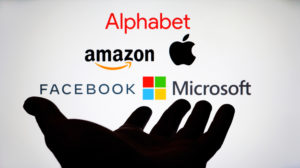
Anger Builds Over Big Tech’s Big Data Abuses

The surveillance economy created by big tech firms is coming under greater scrutiny thanks to legal actions like the Department of Justice’s anti-trust lawsuit against Google this week and films like “The Social Dilemma,” which was released last month. The villagers on the Internet clearly are angry, but will that anger translate into action? That remains to be seen.
While the rest of the world can’t wait for 2020 to end, the year has turned out to be a real windfall for the likes of Alphabet (parent company of Google), Facebook, Apple, and Amazon. Thanks to COVID-19 and the ensuing economic lockdown, hundreds of millions of people have been stuck in their homes, leaving the Internet as the critical lifeline for both work and play.
Investors have certainly responded. From the end of the first quarter to the end of the third, the collective market capitalization of those four companies, plus Microsoft, has grown 50%, from about $4.3 trillion on March 31 to $6.9 trillion on September 30. Besides oil giant Saudi Aramco, they are the five most valuable publicly traded companies in the world.
That monetary statistic, perhaps more than other, demonstrates the incredible power and influence over our digital lives that the tech firms possess. But is Big Tech using that power responsibly? Not if you believe the producers of The Social Dilemma, the “docu-drama” that was released on Netflix in early September.
The film chronicles the rise of social media and the damage it’s causing to individual viewers as well as society as a whole, including the rise of depression among children, rising teen suicide rates, the spread of political disinformation, and the general balkanization of American public discourse.
With access to insiders from Big Tech firms, the film’s producers provide a close-up view of the massive data crunching operation happening just out of view. The crux of the film is that consumers are unknowingly handing over their personal data to the technology giants, who use it to create sophisticated machine learning models to target each individual. Based on these models, which can be contain upwards of 30,000 variables per person (per a 2016 ProPublica report about Facebook cited in the movie), the social media companies can be extremely fine-grained in how they target users with content and ads.
Big Tech’s machine learning expertise is the key to its remarkable ability to know what users will respond to, and is the source of the addictive nature of social media. Like mice hitting the buzzer to get a piece of cheese, social media sites have essentially hacked the central nervous systems of people, and trained people to respond to stimuli in order to get that sense of satisfaction.

Children who spend the most amount of time on social media have higher rates of depression, studies suggest (pathdoc/Shutterstock)
A side effect of that personalization is that nobody has the same experience on the Web, including what news stories we see. That phenomenon led The Markup last week to launch the Citizen Browser Project, which is an initiative “designed to measure how disinformation travels across social media platforms over time.” By tracking what news is displayed to the Web browsers of a statistically valid sample of 1,500 users, the project hopes to reverse engineer the algorithms that Facebook and YouTube use to select which news to share with users.
“Social media platforms are the broadcasting networks of the 21st century,” said The Markup’s editor-in-chief Julia Angwin, who was a 2019 Datanami Person to Watch. “They dictate what news the public consumes with black box algorithms designed to maximize profits at the expense of truth and transparency.”
The algorithms that guide people to consume certain content is certainly one concern. But another concern is the lost opportunity cost associated with being constantly inundated with digital stimuli, says Pankaj Chowdhry, the CEO and co-founder of FortressIQ, a process automation firm based in San Francisco.
“It’s the idea that you’ve got all these signals coming in that can influence you, and even if they’re not influencing you, they can keep other data out because you’re inundated with this,” Chowdhry tells Datanami. “It’s a DDOS attack against free will.”
The Silicon Valley tech giants have lost their moral bearings and are no longer operating within society’s bounds of right and wrong, says Chowdhry, who has spoken up about the importance of ethics in AI before. “We know that every time that notification light goes off, there’s a little dopamine hit that comes out,” he says. “Using that for good is something we have to figure out.”
The ability to sell extremely targeted advertisements to users has been very good for Google and Facebook, which on course to record $31.4 billion in advertising in the U.S. in 2020. However, that’s just a fraction of the advertising business for Google, which brought in nearly $135 billion in advertising in 2019, about 70% of its total revenues.
The astonishingly fast growth in Google’s advertising likely was a factor in the Justice Department’s decision to file a lawsuit on Tuesday alleging that Google violated the Sherman Act by abusing its monopoly position as the most dominant search engine on the Internet. The Justice Department says that, by forcing pre-installation of its search applications on mobile devices and entering into other exclusivity agreements, Google harmed competitors and consumers.
The DOJ alleges that Google is “the monopoly gatekeeper to the Internet for billions of users and countless advertisers worldwide. For years, Google has accounted for almost 90% of all search queries in the United States and has used anticompetitive tactics to maintain and extend its monopolies in search and search advertising.”
Google responded to the lawsuit by saying that it was “deeply flawed” and “would do nothing to help consumers.” The Mountain View, California company insists that it’s “trivially easy” for users to select other search engines to use on their computers or devices.
The business model of delivering free services to people in exchange for permission to collect their personal data and data about their online behavior, quite obviously, has been an enormous success. Figuring out what to do with all this data was the original “big data” use case for the Silicon Valley giants, and now thousands of startups are looking to leverage that model–as well as all of the great open source technology that has come out of this effort–in hopes of “disrupting” other industries.
But consumers may not be the only ones who are being harmed through this big data business model. In fact, according to Kasper Skou, the CEO and co-founder of Semasio, any company that utilize the Tech Giants’ algorithms to seek eyeballs for their marketing and advertising initiatives also end up being victimized in the big data crush.
“If all you do is you upload your CRM database to the walled gardens every month in order to keep getting the kind of campaign results that you’re used to, you’re not getting any wiser,” Skou tells Datanami. “To a certain extent, the whole model is to keep you as stupid as possible, and every time you get hungry, you have to come back, and you have to buy a fish. They will not teach you how to fish. It is not their model.”
The Tech Giants are extremely generous when it comes to open sourcing the wonderful technology on which their big data business models are based. Datanami has spent years writing about that technology and covering the innovative ecosystem of vendors that built up around it. But when it comes to the actual machine learning models the Tech Giants built to target billions of consumers who use their platforms, that generosity suddenly ends.
“To a certain extent, as you saw in the Social Dilemma, they’re weaponizing your data on your behavior against you,” Skou says. “I’m not saying that it’s quite as nefarious for brands. But I’m also saying that it’s not too far off.”
Instead of handing what amounts to their entire customer database over to the tech giants to seed the algorithms with real-world customer data, Semasio advocates that companies build their own big data practices and learn how to use machine learning tools and data to connect with customers and prospects on their own. To that end, Semasio works with The Trade Desk, which runs an advertising buying network that is separate from the big dogs, but still has access to those platforms.
There’s no denying that the tech giant’s have great algorithms, and companies may only get 90% of the results when they begin to become technologically self-reliant, Skou says. But the tradeoff for making less money in the short term will pay off with long-term health, he says.
“They’re hooking them on their crack, just like they are with consumers,” Skou says of companies leveraging Big Tech’s advertising muscle. “Do you want to be rich or do you want to be independent and strategically sustainable? If you want to be rich right now, then keep taking the crack–but understand that it’s crack, and as long as you’re on the crack, you’re not getting any wiser and it’s getting harder and harder to get off of it.”
The idea that consumers and corporations have collectively given up their most valuable commodity –their data – for a short-term gain sounds incredible, but it’s becoming increasingly evident that that is exactly what is going on. The decision, then becomes what to do about it. The first step, most experts agree, is taking back control of data.
“I think in 50 years when people look back on this and see the amount of information that we gave away for free email, they’re going to be just astounded,” FortressIQ’s Chowdhry says. “You did what just to get free email? Just pay the 99 cents!”
Related Items:
It’s Time to Implement Fair and Ethical AI
Crazy Idea No. 46: Making Big Data Beneficial for All
Big Data Backlash: A Rights Movement Gains Steam






























